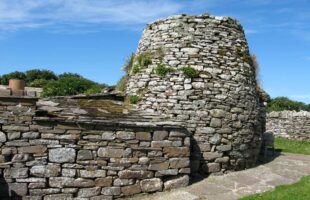The History of Kirbuster Farm Musuem
This unique building with its original central hearth, called a ‘firehoose’, is a rare survivor dating from the 16th century. The name Kirbuster come from the Old Norse kirkju bolstadr, meaning church farm. A nearby mound is said to be the ruins of a medieval chapel.
Remarkably, it was lived in by the Hay family until 1963, although with some modern improvements. It was bought by George Argo, who let visitors look round the historic building. After George’s death in 1982, Kirbuster was still open a place that you could visit.
In 1987 the Argo family generously donated the building to the Orkney Islands Council, to be used as a museum. A plaque commemorating George Argo is prominently featured on the gable wall, facing the path that leads to the building.
The original ‘neuk bed’, built into the wall and with two stone slabs forming the opening into it, was discovered when a modern interior wall was removed by George Argo. The house has been extended at both ends to provide extra living accommodation. A lintel stone above the door into the extension beyond the ‘firehoose’ has the initials ‘KN/JS’ and the date 1723, commemorating the marriage of Katherine Nisbet of Kirbuster to John Spence of Durkadale. It has been laid upside down, reflecting an old tradition that the devil could not pass through something that he couldn’t understand.
This ancient building compliments the later design of Corrigall Farm Museum . By visiting both sites, you get a feeling of how traditional houses developed in Orkney over the centuries.


